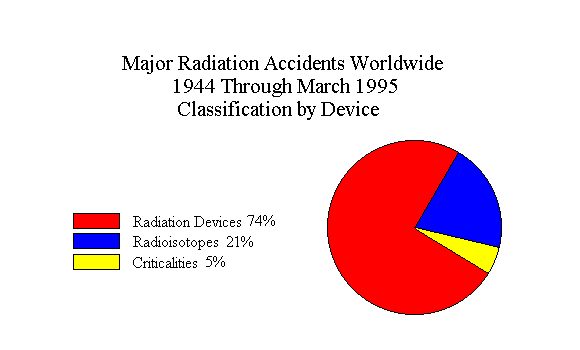![]()
The radiation accidents that have occurred since 1944 can be broken down into three general categories: radiation devices, radioisotopes, and criticalities.(Source: Oak Ridge National Laboratories)

Radiation devices are those machines that produce radiation. These include sealed sources for industrial radiography, teletherapy, and accelerators. Industrial radiography has many uses. Used to x-ray metals and welds, it can evaluate uniformity and strength in airplanes and bridges to ensure safety and detect metal fatigue. Industrial sources are also used in manufacturing to ensure that the proper thickness of material is being produced. The paper and metal industries are dependent on this technology. More recently, sealed sources have been used to irradiate food. This effectively kills the bacteria and organisms that spoil food while leaving the food intact. In combination with newer packaging techniques, perishable food treated this way has a shelf life of year without affecting the quality of food. A common misconception is that food treated this way becomes radioactive. No radioactivity is transferred or created in the food. The minor chemical changes that occur are identical and in a much smaller amount than what is seen in conventional and microwave cooking.
Teletherapy is one of the medical uses of radiation. Tumors, because of thier high rate of growth are often slightly more susceptible to radiation than normal tissues. By treating a patient with regular doses of radiation to the tumor region, the cancer can be significantly decreased or even killed altogether.
Accelerators are used in industry and research to produce radioactive materials. By bombarding a stable material with nuclear particles, radioactive isotopes can be produced. Accelerators are also used in medicine to treat cancers.
These accidents result only in exposure. There is no chance for contamination by radioactive materials. The breakdown of the number of accidents that have occurred due to radiation devices are as follows:
Radioisotopes are materials that are radioactive. Radioisotopes are commonly used in research labs as tracers to identify complex biological and chemical processes. The amounts used in these situations are very small and generally pose no significant health risk when proper care is used. If however these isotopes enter the body and localize in an organ system, they can cause serious effects.
Medicine also makes good use of the properties of radioisotopes. Nuclear medicine, the specialty of using unsealed isotopes for diagnosis and therapy, commonly uses radiopharmaceuticals in its proceedures. By knowing the chemical form and biologic distribution of a radioactive material, its localization in various organ systems can be used to diagnose a variety of diseases. If a radiopharmaceutical is used that produces a large amount of radiation locally, conditions such as hyperthyroidism (Grave's Disease), thyroid cancer, and the pain resulting from cancer spread to the bones can be effectively treated.
In the event of contamination by these radioisotopes, it is essential to know what chemical form the materials is in and how it is distributed in the body. By knowing this information, efforts can be made to help remove the radioactive materials from the body.
The breakdown of accidents involving radioisotopes is as follows:
A criticality is an accident that results in an uncontrolled nuclear chain reaction. Very specific conditions are needed for one of these accidents to occur. Bringing too much radioactive material in a highly pure form together results in a chain reaction that generates considerable heat and radiation. It is this principle, in a controlled situation, that results in the large amount of power that is generated from a nuclear power plant.
The breakdown of accidents that are classified as criticalities are as follows: